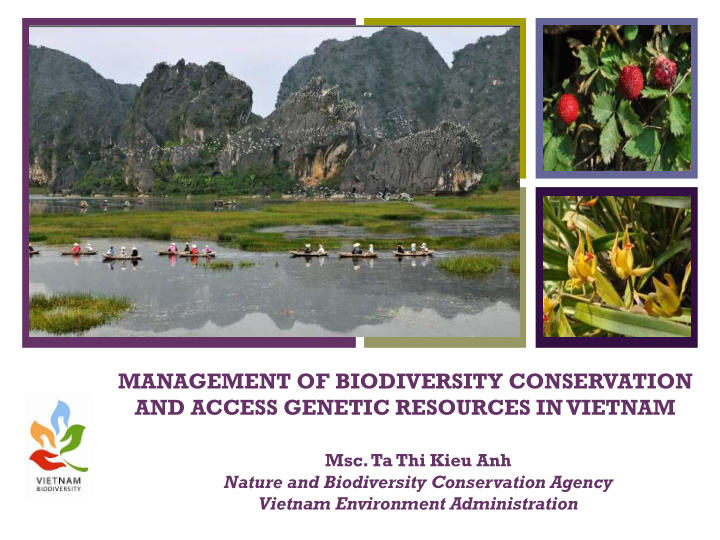



+ MANAGEMENT OF BIODIVERSITY CONSERVATION AND ACCESS GENETIC RESOURCES IN VIETNAM Msc. Ta Thi Kieu Anh Nature and Biodiversity Conservation Agency Vietnam Environment Administration
CONTENT OF THE PRESENTATION + ➢ Part 1. Biodiversity Conservation in Vietnam ➢ Part 2. Management of Access and Benefit sharing from utilization of genetic resources (Decree 59)
Part 1. Biodiversity Conservation in Vietnam +
+ Vietnam is a rich in biodiversity ◼ S = 331.210 km² ◼ Sea area = 1.000.000.000 km² ◼ Wetland area = 10.000.000 ha ◼ Forest cover = 14.415.381 ha ◼ Indo-Burma biodiversity hotspot ◼ 16 th of the world for species diversity ◼ 16% of all global species found ◼ 63 IBA ◼ 6 of 238 ecoregions
+ Vietnam is a rich in biodiversity At present in Vietnam, about 50,000 ➢ species have been identified, consisting of nearly 7,500 microorganisms; 20,000 terrestrial and water plants; around 10,500 terrestrial animals; about 2,000 invertebrates and freshwater fish; and over 11,000 marine species. In the composition of the identified ➢ species, 882 rare plants and animals with high economic value are threatened at different levels, which are listed in the Vietnam Red Book 2007. According to estimations, Vietnam is one of the centres with highly diverse local genetic resources of plants and animals in the world, including about 800 crop varieties, and 14 key cattle and poultry varieties.
+ International Agreements and Cooperation Wetlands of International Importance ➢ 1989 (Ramsar Convention) Covention on Biological Diverstity (CBD) ➢ 1994 Convention on International Trade in ➢ Endangered Species of Wild Fauna and Flora (CITES) 2004 Cartagena Protocol on Biosafety ➢ Nagoya Protocol on ABS ➢ 2014
+ Legal frame work The Biodiversity Law, 2008; ➢ The Environmental Protection ➢ Law, 1993 (amended in 2005, 2014); The Forestry Law, 2017 ➢ The Fisheries Law, 2003 ➢ (amended in 2017);
+ Legal frame work ❖ The Biodiversity Law enacted 2008. ❖ Marking an important milestone for conservation. For the first time, the Biodiversity Law elevates the principles and priorities of biodiversity conservation to the level of law independent of other sectors in Vietnam. ❖ Main Issue: ✓ Biodiversity conservation planning ✓ Conservation and sustainable development of natural ecosystems ✓ Conservation and sustainable development of species and genetic resources ✓ International cooperation on biodiversity ✓ Mechanisms and resources for biodiversity conservation and sustainable development
Part 2. Management of Access and Benefit sharing from utilization of genetic resources (Decree 59) +
+ Decree 59 on ABS: ➢ The Decree 59 was issued in May 2017 and came into effect in July 2017. ➢ The Decree consists of 28 articles in 5 chapters, detailing: ▪ Procedures for registration and negotiation of an ABS contract to application for access to GRs and benefit- sharing, ▪ M&E of compliance through reporting. ▪ Rights and obligations of the involved parties are also concretized, including the responsibility of National Focal Point (NFP) and a National Competent Authority (NCA) to grant licences on ABS. ▪ To facilitate its implementation, the Decree provides 9 The Decree 59, 2017 forms, which assist the application of the Decree in practice.
+ Principles in management of access to GRs and the sharing of benefits arising from their utilization: 1. The State of Vietnam has national sovereignty for all GRs in its territory. 2. User of GRs who are foreign individuals or organizations are allowed to access to GRs only when licensed by the competent national authorities. 3. The State encourages domestic organizations and individuals to carry out research and development activities on GRs . 4. Benefits arising from the utilization of GRs must be shared in a fair and equitable manner among stakeholders, contributing to the effective management of biological resources, promoting scientific research processes and the commercialization of GRs , and particularly focusing on the role of local communities in the conservation and sustainable use of GRs .
+ Scope and Regulated entities ❑ Scope: ➢ Applied to all GRs being accessed for utilization purpose, including biochemical compounds and derivatives thereof (Art. 3.11, Decree 59); Definition of "utilization of GRs", o "biotechnology", "derivatives"; Not covered: GRs for direct usage (eg. o purchase of herbal plants for tea bags production, no R&D involved) ➢ TK not included. ❑ Regulated entities: Applies to individuals and organizations engaged in activities related to access to GRs for the purpose of utilization for research or development of commercial products.
+ National Functional Agencies ❑ For the National Focal Point (NFP): The Ministry of Natural Resources and Environment (MONRE) is designated as the NFP of the Nagoya Protocol ❑ For the National Competent Authorities (NCAs): The Government assigns the authority to grant, renew and withdraw licenses to access GRs to the MONRE and Ministry of Agriculture and Rural Development (MARD) , which specifies: Ministry of Agriculture and Rural Development Access to GRs of plant varieties, livestock breeds, aquatic species and forest seedlings Ministry of Nature Resources and Environment Access to all other cases (including wild GRs, microorganisms,…)
+ Access Requirements
+ Access Requirements
+ Vietnam ABS - Clearing House http://vietnamabs.gov.vn
+ Thank you for your attention !
Recommend
More recommend